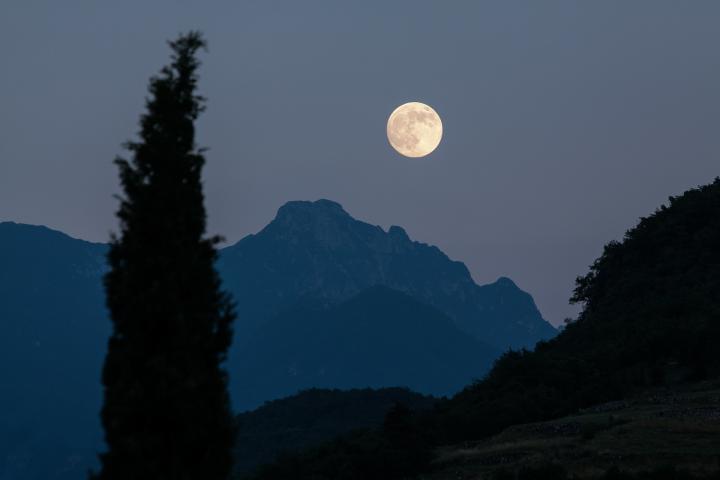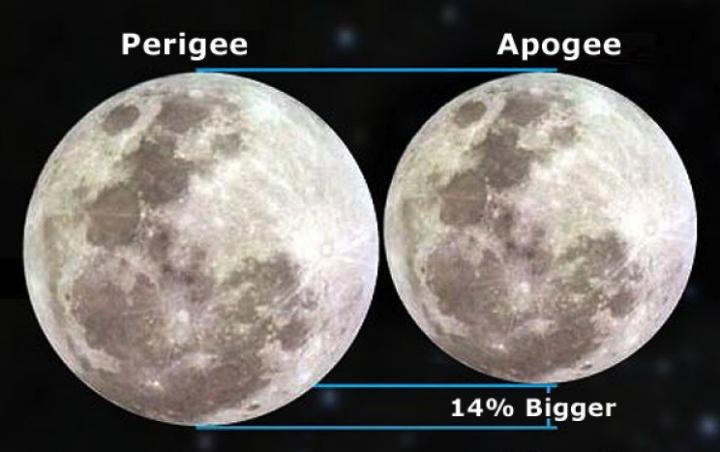WHAT IS A SUPERMOON?
FIND OUT WHEN TO SEE A SUPERMOON IN 2021

There are two supermoons in 2021—and the next one is in April 26. What is a supermoon? We agree that it’s a catchy word and anything that encourages us to explore the night sky is positive—but let’s also get our facts straight.
Generally speaking, a supermoon is a full moon that appears larger than a typical full moon due to it being closer to Earth.
However, there’s a bit more to it than that! In fact, there are a couple definitions of “supermoon” out there. Let’s go through the two most popular ones, which we’ll refer to as the “broad” definition and the “strict” definition:
- Broad Definition: A supermoon is a new or full moon that occurs around the same time as perigee (the point in the Moon’s orbit where it is closest to Earth). By this definition, there can be several supermoons in a year.
- Strict Definition: A supermoon is the single closest new moon and full moon of the year. By this definition, there can be only two supermoons each year (a full moon supermoon and new moon supermoon).
In popular usage, most folks go by the broad definition, since it’s much more exciting to be able to talk about multiple supermoons instead of just one or two. Plus, “supermoon” tends to refer only to full moons, rather than both full and new moons. (This makes sense, given that new moons are essentially invisible from Earth.)
Another measure that’s used to determine if a full moon is a supermoon is its physical distance from Earth. The exact distance cutoff varies, but we generally adhere to the idea that a full moon occurring at a distance closer than 224,000 miles (360,000 km) is considered a supermoon.
HOW MANY SUPERMOONS ARE THERE IN 2021?
Going by our broad definition of the term (and ignoring new moons), there will be two supermoons in 2021.
| Name | Date | Distance from Earth |
|---|---|---|
| Full Pink Moon | April 26 at 11:33 P.M. EDT | 222,211.7 miles (357,615 km) |
| Full Flower Moon | May 26 at 7:14 A.M. EDT | 222,116.6 miles (357,462 km) |
| Perigee distance data courtesy of Fred Espenak, www.Astropixels.com. | ||
(Note: Some sources also classify March and June’s full Moons as supermoons, but they don’t quite fit our definition.)
A Supermoon Lunar Eclipse
May’s full Moon is particularly notable for two reasons:
- It’s the closest supermoon of the year, sitting at a distance of 222,116.6 miles from Earth—about 100 miles closer than April’s supermoon.
- It coincides with a total lunar eclipse in some areas, which means that it will take on a reddish hue during the eclipse’s maximum. In other words, it will be a “blood moon.”
The eclipse will only be visible in some parts of the world, unfortunately. If you’re located in western North America, however, you’re in luck! Read more about this year’s eclipses here.

WHY DO SUPERMOONS OCCUR?
It all comes down to the fact that the Moon’s orbit around Earth is not a perfect circle—in fact, it’s an elliptical (oval) shape.
Because of this, the Moon’s distance from Earth changes as it travels around our planet. Additionally, Earth doesn’t sit directly in the middle of this elliptical orbit, so there are points in the Moon’s orbit where it is closest and farthest from Earth. These points are called perigee and apogee, respectively.
- Perigee is the point in the Moon’s orbit where it is closest to Earth.
- Apogee is the point in the Moon’s orbit where it is farthest from Earth.
The Moon makes one full orbit around Earth in about 29.53 days, which means that it reaches its perigee and apogee points about once a month. When this occurs at the same time as a full moon, it’s called a perigee syzygy—or, more commonly, a supermoon!
- “Syzygy” is the astronomical term for when three or more celestial bodies (such as the Sun, the Moon, and Earth) line up. When the Sun, Earth, and Moon form a syzygy, we experience a full or new moon, depending on whether the Moon is between the Sun and Earth or Earth is between the Sun and the Moon.
WHERE DID THE TERM “SUPERMOON” COME FROM?
Although it has been all over the news in recent years, “supermoon” is not an official astronomical term. In fact, it didn’t even exist until astrologer Richard Nolle coined it in 1979!
At the time, Nolle defined a supermoon as “a new or full moon which occurs with the Moon at or near (within 90% of) its closest approach to Earth in a given orbit.” This definition is what most people go by today, though we tend to pay attention only to the full moon supermoons, since they’re a lot more interesting to look at!
DOES A SUPERMOON REALLY LOOK BIGGER?
Given that a supermoon full moon is closer to Earth than a normal full moon, it does appear larger—about 7% larger, technically speaking. This means that the difference between a full moon at perigee and a full moon at apogee can be up to 14%, which is significant.

Here’s the key fact, however: Unless you were somehow able to compare a normal full moon and a supermoon side by side in the sky, it’s nearly impossible to perceive a 7% difference in the Moon’s size.
Even if you could somehow place the year’s biggest possible Moon (the perigee full moon) next to the smallest one (an apogee full moon) in the sky, you’d just barely tell the difference. And that’s with the absolute extreme Moons!
The bottom line is that it’s difficult to truly perceive any difference at all in the Moon’s size from one month to the next, or one night to the next, so don’t get your hopes up about seeing a gigantic Moon out there.
THE MOON ILLUSION
Okay, if you want to be guaranteed of seeing a huge-LOOKING Moon, it’s easy… Simply watch the Moon when it’s rising or setting!
A Moon down near the horizon will always look enormous, thanks to a well-known phenomenon called the Moon illusion, which makes our minds exaggerate the size of objects near the skyline.
Try it! If you want a truly massive supermoon, you can have it—any night!
ABOUT THIS BLOG
Welcome to “This Week’s Amazing Sky,” the Almanac’s hub for everything stargazing and astronomy. Bob Berman, longtime and famous astronomer for The Old Farmer’s Almanac, will help bring alive the wonders of our universe. From the beautiful stars and planets to magical auroras and eclipses, he covers everything under the Sun (and Moon)! Bob, the world’s mostly widely read astronomer, also has a new weekly podcast, Astounding Universe
https://www.almanac.com/what-supermoon?trk_msg=10BTKD6EVNT4JBU075PR5856NG&trk_contact=0857QLVEDPDQR9SNGDLIMCOBG4&trk_sid=UR4K9K8DTS5V1ABRM05PQN8UCS&utm_source=Listrak&utm_medium=Email&utm_term=What+Is+a+Supermoon%3f+(read+more)&utm_campaign=Companion+Daily
No comments:
Post a Comment
Note: only a member of this blog may post a comment.